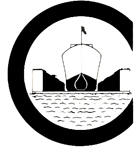Over 150 years of expertise in marine railways and floating dry docks
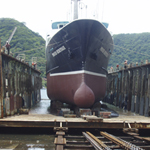 |
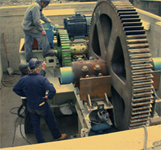 |
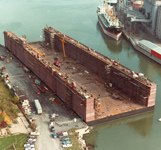 |
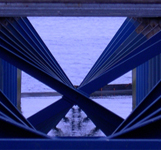 |
|
An
Introduction to Railway Dry Docks
and Transfer Systems
Part
10 - Construction Procedures
|
3. Side haul railway dry docks |
The construction of a railway dry dock involves several radically different skills so that it is rare that a single contractor can undertake the entire project with his own forces. The work is usually divided into two basic parts - the water construction and the land construction. The contractor undertaking the water construction is generally responsible for dredging and excavation underwater, driving the pile foundation or putting in concrete footings, building the timber track, and placing it on the piles or installing the steel track. Usually the construction of the underwater track and foundation is carried out in the wet, using divers to cut off wooden piles and to place the track to line and grade; rarely this work can be carried out in the dry. In the past we used timber construction entirely for this underwater portion of the track, since timber was available and economical and had indefinite life in the seawater when adequately protected against marine borers. More recently many designs have called for steel track because suitable timber has become more difficult to procure and has risen in price disproportionately. In either case, the practice is to prefabricate the track in the dry to assure the necessary precision of alignment and then install it. Crandall ahs experienced diving crews to carry out pile cutting, place the track to the specified lien and grade, and do any replace shimming. The kill and know-how of doing track work underwater are vital to achieving economy and speed of construction. Once properly built and installed, a timber track underwater has from 30 to 40 years of life before any major maintenance is required; a steel track ahs a similar life expectancy, damaged more by salt water than fresh. The land portion of the work may be undertaken by another contractor or the shipyard itself. This work consists of construction of the concrete track and machine foundation, installation of the machinery, installation of the roller system on the track, and erection and fitting out of the cradle. The structural steel cradle is generally fabricated and painted by a steel fabricating shop, and when possible, the same shop is asked to do the erection so that the responsibility for the work is under one contract. Construction of a railway dry dock requires substantial time, and procurement of the cradle and machinery is a long lead-time activity. Planning and early specification of the elements are therefore very important to get the job done in the least time at the best cost. Crandall is set up to furnish the machinery, roller frames or only their castings, chains, bilge block equipment, chain gear, and other miscellaneous parts that are special and not readily available on the open market. Refinement of our designs over the years has resulted in superior products for the purpose, which combine our design and specification of suitable materials with quality control inspection so that everything fits properly and functions with no problems in the very hostile environment of the sea. Next: Restoration and enlargement
|
Progress...the result of never being satisfied
Crandall
Dry Dock Engineers, Inc.
Established 1854
(888) DRYDOCK crandalldd@aol.com
